1897
First Sikhs, Canada Kesar Singh 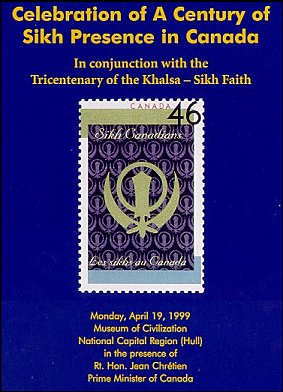
1899 Sikhs Allowed to Land in S.F 1904 Guru Granth Sahib Ji 1906 Diwan Singh and Dhana Singh Poonian arrive in U.S. 1906 Khalsa Diwan Society Established
1906-1922 Astoria,
Oregon--"Hindu Alley"
1907 Anti-Hindu
Riot, Bellingham, Washington
1908 Vancouver,
B.C. First Gurdwara 1909
The Awakening of the Sikhs.
1911 Holt, California - Gurdwara Property 1911 First Sikh Prayer-Guru Granth 1912 Stockton Gurdwara property 1912 Pacific Coast Khalsa Diwan Society 1913 Sikh wrestling prowess, March, 1913. Astoria, Oregon 1913 Gadar
first meeting, Astoria, April, 1913. 1914 Komagata Maru departs to India 1915 Stockton Gurdwara First Permanent structure 1915 Dedication
of Stockton Gurdwara, transcript of 1915 news item 1921 Hazing of Hindus [unwind turbans] 1923 Bhagat
Singh Thind case. U.S. vs Thind 261 US 204(1923). 1948 El Centro California Gurdwara established. 1956 Dalip
Singh Saund elected member of Congress
1965-... Dr.
Bruce LaBrack's Study of South Asian Immigrants. The Indian community increased, especially the Sikhs, between 1965-75. 1993- First turbaned Sikh elected in Canadian Parliament. 1994 Prabhu-Poonam Goel & Rekhi Grant to Benefit Girls' Education in India1998 Amartya Sen received the 1998 Nobel Laureate in Economics: For his contribution to welfare economics. http://almaz.com/nobel/economics/1998a.html 1998 Founding
of First Sikh Preschool in Northern California - Yuba
City, California 2000 Dosanjh is British Columbia Premier, Feb 21, 2000-June 2001 2000 Immigration from India to the U.S. from 1820 to 2000 2000 Population census 2001 Sikh Leaders meet President Bush 2002 Desshpande Gives $20M to MIT. India-West Jan. 11, 2002 page 1 Asian-Indian (Indo-Americans) Contributions 2002 Canadian Prime Minister gives Abbotsford, British Columbia Sikh Temple heritage status 2003 First Indian in the US Army Killed in Iraq 2004 "Sikhs: Legacy of the Punjab" at the National Museum of Natural History, Smithsonian Institution 2004 "Mohini Bhardwaj" An Indian American girl in the U.S. Olympic Team 2004 "White House marks 400th anniversary of Guru Granth Sahib" 2004 Second Indian-American elected to Congress, Bobby Jindal |
| 1897 First Sikhs, Canada
The first Sikhs who visited Canada were the soldiers of the British Army
(the Sikh Lancers and Infantry). They passed through Canada ( traveling
by train from Montreal to Vancouver) on their way back to India, after participating
in the Diamond Jubilee celebration of Queen Victoria in London, England,
in 1897. On their way back from Canada to India, they met other British
Army Sikh soldiers in Hong Kong, Shanghai and Singapore and told them about
the opportunities in Canada, before going back to Punjab, India. A
monument has been erected to their honor at the GURDWARA SAHIB, at 8000
Ross Street Vancouver B.C.
1899 The four Sikhs who arrived on the Nippon Maru the other day were permitted
yesterday to land by the immigration officials. The quartet formed the
most picturesque group that has been seen on the Pacific Mall dock for
many a day. One of them, Bakkshlled [sic] Singh, speaks English with fluency,
the others just a little. They are all fine-looking men, Bakkshlled Singh
in particular being a marvel of physical beauty. He stands 6 feet 2 inches
and is built in proportion. His companions-Bood [sic] Singh, Variam [sic]
Singh and Sohava Singh-are not quite so big. All of them have been soldiers
and policemen in China. They were in the Royal Artillery, and the tall
one with the unpronounceable name was a police sergeant in Hong Kong prior
to coming to this country. They hope to make their fortunes here and return
to their homes in the Lahore district, which they left some twenty years
ago.
1904 Bhai Arjan Singh of village Malak, Dist. Ludhiana (Punjab) was the first Sikh to bring the GURU GRANTH SAHIB JI (the holy scripture of the Sikhs) to Vancouver. And then the Sikhs started to congregate regularly for worship, using their houses for this purpose. (Source: Khalsa Diwan Society, British Columbia)
1906 Diwan Singh immigrated to America in 1906 and by the 1940s, farmed large tracts of farm land in Arizona. "Arizona has many large cotton farms. But many of the farmers started on a small scale. Diwan Singh was one of the more colorful pioneers. Born in India, he immigrated to America in 1906. Singh was a common laborer when he drifted into Casa Grande in 1924. He wanted to farm but was penniless. The only land he could get had hard, alkali soil. But with a horse and a mule he plowed 80 acres and planted cotton. Singh did well. In 1932 he was able to buy the first Caterpillar tractor in the Casa Grande area. By the 1940s he was farming 9,000 acres of land." (Arizona's Heritage (high school textbook), 1983.)
1906 The Khalsa Diwan Society
|
|||||||||||||||||||||||||||||||||||||||||||||||||||||||||||||||||||||||||||||||||||||||||||||||||||||||||||||||||||||||||||||||||||||||||||||||||||||||||||||||||||||||||
| AMAR SINGH PRESIDENT |
GOPAL SINGH SECRETARY |
GURDIT SINGH COMMITTEEMAN |
|---|
Khalsa Diwan Society Jan 14, 1932
"Hindu Alley" Men Were Peaceable (1906-1922)
For more than 15 years Astoria had a Hindu Alley, a block of houses on Birch Street near the old Hammond Mill in Alderbrook.
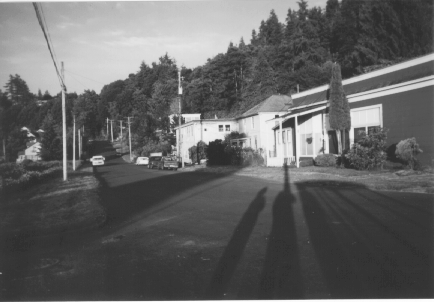
Mention the Hindus to an old-timer, and the immediate response is, "Yes, I remember them. They all wore white turbans. They were tall men. They were good wrestlers." But beyond that very little is commonly known about the Hindus, because, as most of the immigrant groups in the early days, they kept to themselves.
No one could know exactly when the Hindus came to Astoria, but from piecing together the information from about 20 old-time Astorians interviewed, this reporter has concluded that they probably came in 1906.
According to Cecil Moberg, who grew up in Alderbrook, there were 12 bunk houses along the waterfront between 51st and 52nd Streets on Birch where the most of Hindus lived. He said that about four men lived in each house.
Hattie Spencer said that 12 Hindus lived in the house behind her home at 4777 Cedar, renting it for a dollar each for a month.
For the "Hindu Alley," bunkhouses, there was a central cook house, said Chris Simonsen, where they ate Indian food. He remembers their making chupatti pancakes patting the dough between their hands. He also said that they would only buy live chickens, and only roosters, not hens. The other Hindus were all single men who came to work for the mill.
Although most were single men, Mrs. Spencer remembers hearing that "at one time there were two Hindu women dressed as men who worked at the mill for quite a while with the men, until they were found out." But that was all she knew. There were four children in the Hindu family. Moberg said that the two older boys, Kapur and Budha Singh, attended school with him.
"The boys had such beautiful white teeth," he remarked, recounting that one day the boys explained how they cared for their teeth: "They picked a willow twig from the swamp and used it to clean their teeth."
Feared Hindus
Many of the old-timers reported that as children, they were afraid of the Hindus.
"We thought they were terrible coming with their turbans," said Mrs. Spencer. "We were afraid of them at first. But my dad said, "They have to make a living as the rest of us. We are foreigners, too."
"As children, we were afraid of them because they were great big men," Moberg added.
Chris Simonsen, who lived across from the bunkhouses, remembers as a child throwing snowballs at Hindus, trying to knock off their turbans, in about 1910.
He also said that men would pick fights with the Hindus when they came home from town on the last street car in the evening. "For the most part, however, the Astoria community considered the Hindus "vastly interesting, and peaceable." "The Hindus kept to themselves and didn't interfere with the whites," said Mrs. Spencer.
Agile Wrestlers
The Hindus were most known for their prowess and agility in wrestling, back in the days when wrestling was "real honest-to-goodness wrestling," in Bill Wootton's words.
They would hold wrestling bouts in Rosenberg Hall, about 11th and Exchange.
"They were light-heavyweight champions," Wootton said. "They used scientific holds and used their science and ability to get in and out of the holds."
Although many immigrant groups who came to the United States came because they would work for cheap wages, that was not true of the Hindus.
Helmer Lindstrom of 4374 Cedar, remembers that the Hindus "never undercut wages" - they would never agree to work for less than the other employees.
According to Peters, they worked 10 hours a day, six days a week for 128 a week - at least during the period after he arrived in 1916.
For a discussion of the Gadar first meeting in Astoria in April, 1913, click.
SOURCE: The Daily Astorian. Astoria, Oregon Centennial,
1873-1973 Edition. April 26, 1973: 9B.
Turbans: Filmed in Astoria, About Astoria
ASTORIA REVISITED And Autobiographical Note By Ms..Kartar Dhillon
Hindus Uppertown
Journey To India
By Ms.Kartar Dhillon
The Parrots Beak. By Ms.Kartar Dhillon
Witness to the Gadar Era . Interviews with Ms. Kartar Dhillon
Photographs of Kartar Dhillon's family
1907
ANTI-HINDU RIOT BREAKS OUT
"On September 4, 1907, a mob of about 500 men assaulted boarding houses and mills, forcefully expelling Hindus from Bellingham (Washington)in what is now known as the Anti-Hindu Riot.
It began as an attack on two East Indian workers on C Street and turned into a rock-throwing lynching, to 'scare them so badly that they will not crowd white labour out of the mills.' The small police force was overpowered. The next day about 300 Hindus fled Bellingham in fear.
The press, some civic leaders and churches denounced the riots. Threats were later made to other groups, though no major riots occurred."
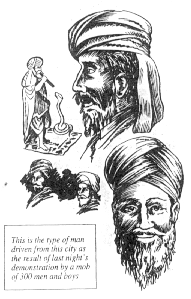
Picture Diagram: "This is the type of man driven from this city as
the result of last night's demonstration by a mob of 300 men and boys."
(5 o/clock extra, Sept. 5, 1907: p. 1&3)
"Driven From Town: ...recreation of an illustration that appeared
in a local newspaper shortly after the Anti-Hindu Riot of Sept. 4, 1907.
The day after the riot, about 300 Hindus fled Bellingham." (Source:
Morning Reveille (Bellingham, Washington), January 27, 1999) SOURCE
OF STORY: Bellingham Herald (January 27, 1999) Reprinted from: The Reveille
& Chris Wolf
|
|||||||||||||||||||||||||||||||||||||||||||||||||||||||||||||||
|
|||||||||||||||||||||||||||||||||||||||||||||||||||||||||||||||
|
|||||||||||||||||||||||||||
|
|||||||||||||||||||||||||||
OTHER ORIGINAL SOURCES FROM: Morning Reveille & The Evening American (Bellingham, Washington)
"Hindus are leaving city" (Sept. 6, 1907: p. 1&2)
"Hindus driven from the city" (Sept. 5, 1907: p. 1&2)
"Mob Raids Hindus & Drives Them From City" (Sept. 5, 1907: p. 1&3)
OTHER MAJOR SOURCE:
Hallberg, Gerald M. "Bellingham, Washington's Anti-Hindu Riot." Journal of the West. Vol(12)1: 163-75. 1973. (also reprinted in The Northwest Mosaic. edited by Halseth. J.A. Pruett Pub., Boulder, Colorado. 1977.pp. 140-155).
1908
Vancouver, B.C. First Gurdwara (Temple) 1908
On January 19, 1908, the first Gurdwara Sahib in Canada was officially opened at 1866 West Second Avenue, Vancouver, B.C. Bhai Balwant Singh Ji was honored to be the first GRANTHI. The Gurdwara Sahib served the greater Vancouver Sikh community until a new Gurdwara was built and occupied on April 25, 1970 at a different site. The first Gurwara property was sold for $100,000 to build the bigger, present, Gurdwara. It was very unfortunate to lose the earlier historic Sikh monument. (Source: Khalasa Diwan Society, British Columbia)
1908
Moving Hindu Colony to British Honduras?
The government of Canada hatched a conspiracy to please the Asiatic Exclusion League and to keep Canada white. The first step the government of Canada took was to pass "an order in council" on January 8, 1908, to ban the entry of Indians into Canada: "All immigrants seeking entry must come to Canada by continuous journey and through tickets from the country of their birth or nationality or citizenship." Now the government of Canada took the second step and suggested that Indians should voluntarily accept to leave Canada and settle in another British colony-- British Honduras. J.B. Harken, interior minister of the federal government, was authorized to make arrangements for all Indian residents of British Columbia to be sent to British Honduras. The meeting was arranged by William Hopkinson, who was born in India of an English father and a Punjabi mother. He knew a bit of Punjabi and could speak Urdu. Bhai Bhag Singh, president of the Khalsa Diwan Society and Bhai Balwant Singh, priest of the Sikh Temple, were approached by Hopkinson. They could not refuse meeting Harkin. Their meeting was held on October 18, 1908. They were forced to send a deputation of two Sikhs, Bhai Sham Singh and Bhai Nagar Singh, to British Honduras with Harkin and Hopkinson. The deputation reached British Honduras on October 25, 1908, and returned on November 7, 1908. In November a congregation was held at the Sikh temple. The temple was not only the place for worship, it was also the headquarters of the Sikh, Hindu and Muslim laborers. It was the residence and the feeding place for the sick and unemployment laborers from India. The hall of the temple was full. Bhai Sham Singh and Bhai Nagar Singh presented their report. The summary of the report is as follows: "The climate of Honduras is not sustainable. Monthly wages are much lower. Fresh water and milk are not available. Sea water is used for washing and bathing. Lots of mosquitoes, flies and many diseases. Labor is contractual. Some Indians working as contractual laborers are having a miserable life. We were asked to accept a bribe of $3,000 to make a report in favor of settling in British Honduras." The congregation passed a unanimous resolution refusing to go to British Honduras...The result was that on November 23, 1908. J.B. Harkin had to inform the government to the effect that the Sikh delegation was against sending any Sikhs to British Honduras. William Hopkinson did not cease his efforts and the government of British Honduras, Colonel E. John Swayne, was invited to British Columbia to convince Sikhs to go to British Honduras. Colonel Swayne had served in India and knew Punjabi and Urdu. He offered $20 a month and a pension of $10 a month after 10 years' service but still he could not find even one Indian willing to go to British Honduras. Later in December 1908 the government of Canada issued a statement that no Indian was to be sent to British Honduras by force. The question of sending Indians to British Honduras was closed forever.
Source: MEHFIL: The Magazine for Today's Indo-Canadian. December 1997, pages 29 and 76.
"Resolved that no member of the Executive Committee of the Sikh Temple should wear any kind of medals, buttons, uniforms or insignia which may signify that the position of the party wearing the aritcle is nothing but a slave to the British supremacy.""He clearly argued that the medals they wore signify that they fought for the British as mercenaries against the cause of our fellow-countrymen, or some free people. The medals acquired by serving in the British army ought to be regarded as medals for slavery. The audience solemnly and unanimously accepted the proposal. Sardar Gharib Singh, a member of the committee of the Sikh Temple, and formerly sepoy 2760 in the Fouteenth Sikh Regiment, who wentto China during the Boxer trouble and acquired a medal for chivalry, took off his medal and declared that he should not wear any medal or uniforn acknowledging supremacy of the British. Later on Sardar Bhag Singh, the Secretary of the Khalsa Divan, who served the Tenth Bengal Lancer Regiment for over five years, made a bonfire with his certificate of honourable discharge. The above incidents are a few of the many genuine proofs of the awakening of the Sikhs. Coming in contact with free people and instituitions of free nations, some of the Sikhs, thought labourers in the North American Continent, have assimilated the idea of liberty and trampled the medals of slavery. There is in this a lesson for the so-called educated people of India and their moderate leaders."
1911
Holt, California
There were no organized societies of Sikhs in the United States until 1910. In 1911, Sardar Basakha Singh and Jawala Singh arranged for a meeting to take place in Holt, near Stockton, to form a Sikhs Unit. A committee was appointed to raise money for the construction of a temple.
1911
First Sikh Prayer - Guru Granth
1912
Stockton (California) Gurdwara, (Temple)
The land was purchased on South Grant Street in September, 1912. The small frame house already standing on this lot was used as a Gurdwara (temple). Guru Granth Sahib was installed and Gurdwara started in 1912. Also in 1912 the Sikh religious flag - Nishan Sahib hoisted for the first time. Baba Vasakha Singh and Baba Jawala Singh Thathian (Amritsar) were the first Granthies.
"Dodan Singh the Hindu and Eddie O'Connell will not meet in a wrestling match here on the evening of March 28. The lid was suddenly clamped on the proposition yesterday when Sheriff Burns notified the manager of the Hindu that O'Connell would not be permitted to wrestle in this city. The sheriff takes this stand because he thinks that the Portland wrestler is not on the square and while he does not object to a good clean wrestling match, his faith in O'Connell appears to be exceedingly limited."
SOURCE: The Daily Astorian. Column: "Water Under the Bridge" compiled by Bonnie Oathes of March 16, 1988 dated 75 years ago.
WRESTLING
"According to Bill Wootton, the Hindus were most known for their prowess and agility in wrestling, back in the days when wrestling was "real honest-to-goodness wrestling." They were light heavyweight champions. They used scientific holds and used their science and ability to get in and out of the holds."
SOURCE: The Daily Astorian. Oregon Centennial,1873-1973. April
26,1973. (p.913)
1913 Alien Land Law, State of California
This law, the first in California, prevented "aliens ineligible for
citizenship" (Chinese and Japanese) from owning property in California.
Though intended primarily to block Japanese immigrant farming. The law
also afected immigrants from India.
April 23, 1913 - Gadar Party first meeting. First Revolt Against
the British to Free India
The first meeting of the party was held on April 23, 1913 in Astoria, Oregon, (U.S.A.) The meeting was held in the Finnish Socialist Hall.
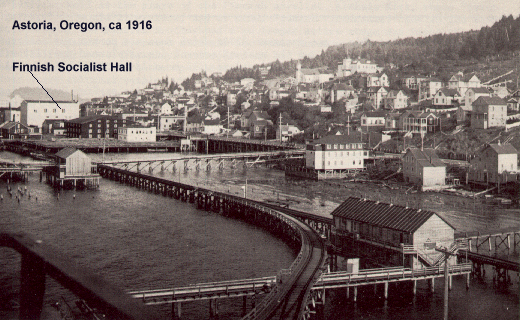
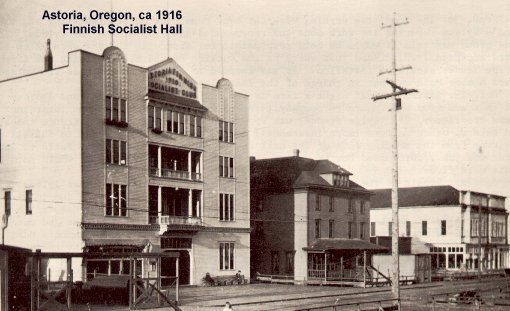
(source of photos:
Finnish American Historical Society of the West. The Theater Finns. Walter Mattila, editor. Portland, Oregon. Finnish American Historical Society of the West. Publication v. 7, no. 2, 1972, p. 2 and 7.)
(source: Liisa Penner, curator, Clatsop County Historial Society).
According to writer Khuswant Singh, this was the first revolt against
the British to free India. He also noted that "although nine out of ten
of the rank and file of the Ghadar Party were Sikhs and the centres of
their activities were Sikh temples, since most of them, were illiterate,
most of the leaders were educated Hindus or Muslims. This saved the Ghadar
from becoming a militant Sikh movement. In fact, it contributed - not
a little - to make the Ghadar the most powerful terrorist movement in
the history of India's freedom movement as well as the first one to rise
above communal considerations."
(Source: Singh, Khuswant. GHADAR 1915. India's first armed revolution.
New Delhi: R&K Publishing House, 1966)
May 23, 1914 Komagata Maru arrives in Vancouver, B.C.
July 23, 1914 Komagata Maru departs Vancouver, B.C. and returns to India.
1915
Stockton. First Gurdwara Building
November 21, 1915 the first of two Gurdwara buildings was finished and dedicated on South Grant Street. Bhola Singh was the priest, Dharam Singh, President and B. S. Inder, Secretary. This original Stockton Temple - a two story wooden structure was the first Indian religious building in the United States. It was designed by W. B. Thomas of Stockton and built by A. J. McPhee for about $3,000. The original small house was not torn down, but has since been used by the residence of the Granthi. On the opening day one of the members, Nand Singh told the Stockton Record that
" the Gurdwara maintains a free dinner room in connection with its temple." He continued: We do not permit our people to become charges on public charityIf a man is hungry and out of funds we feed him. Our dining room is open at all hours of the day and is closed only for a few hours during the night. The unfortunate hungry American will be as welcome as our own people."
go ![]() for a transcript of the article which appeared in the Stockton Record
for November 22, 1915, which reported on the dedication of the 1915 Temple.
for a transcript of the article which appeared in the Stockton Record
for November 22, 1915, which reported on the dedication of the 1915 Temple.
The principal place of business of the Pacific Coast Khalsa Diwan was in Berkeley until October 1, 1917, when its location was moved to Stockton.
NewsPaperClip1. NewsPaperClip2.
 Go to top of the page
Go to top of the page
1917 Asian Barred Zone and Literacy Test
This zone, created by Congress on February 5, 1917, extended the Chinese
Exclusion Act to all other Asians (with the exception of citizens of the
Philippines and Guam, who were under American jurisdiction). The act also
imposed a literacy test on immigrants, so that only those who could already
read and write English would be admitted. The act passed over the veto
of President Woodrow Wilson.
1921
Hazing of Hindu Students [unwind turbans]
"Seniors Rescue Hindus from U.C.
Hazing Crowd
Fight Comes When Effort Made by Sophomores
to Unwind Turbans"
"Berkely, August 15 [1921] - Members of the sophomore class of the University of Claifornia who engaged today in upholding the tradition of the university anent the hazing of freshmen, faced a real problem this afternoon in the form of three Hindu scholars. The three were captured and lined up for hazing, after which a consultation of sophomores was held.
Finally it was decided to make them take off their shoes and wade in
chemistry pond, explaining to them that they were "bathing their
feet turbans to solve the mystery of whin the university's sacred pool."
Then it was decided to unwind theirat might be underneath. To this, however,
the Hindus objected and showed fight. The three finally freed themselves
from their captors and ran frantically for the president's office with
the intention of calling the office of the British consulate at San Francisco
for protection. But they were overhauled by members of the senior class,
who restored the peace.
The three are said to be graduates of Oxford University and are here to
take post-graduate work."
San Francisco Chronicle 8/16/21 6:2
In 1929 a new Gurdwara was built on the enlarged foundation of the old building. The old wooden building was moved to a place near the small frame house. The new brick structure was built at the cost of $35,000. It was dedicated on January 7, 1930.
Sources: Stockton Record, Nov. 22, 1915, p.5; Stockton Record, Aug. 3, 1915,p.4;Stockton Record, Dec. 3, 1932, p.16;Wood in Bibliography;Walker in bibliography; Harbhajan S. Shergill, Lodi, California, Personal communication
El Centro Gurdwara was established in 1948. It had originally been a Japanese temple. World War II dealt a death blow to the Japanese community in the Imperial Valley, and shortly after the war the community leaders decided to sell the temple. The Sikh community bought the temple from the Japense and converted it into a Gurdwara. The buying price, according to an informant, was 18,000 dollars. The framehouse had been used as a kitchen and dining hall also on these occasions until 1954, when a large dining hall was built at a cost of about 18,000 dollars.
Source: Chakravorti, Robindra Chandra. The Sikhs of El Centro: a social integration. Dissertation: University of Minnesota, 1968.
1956
Dalip Singh Saund elected member of Congress.
Dalip Singh Saund was elected a member of the Congress from the 29th Congressional
District in California in 1956, "the first Democrat to be elected from
his district of Westmorland, California, and the first person of Asian
extraction ever elected to Congress in the history of the United States."
Saund, who had come to the United States as a student, received a doctorate
in mathematics from the University of California at Berkeley in 1924,
but he could not get himself a job commensurate with this academic degree
because of the prejudice and discrimination against Asians in California
prevalent at the time. He wrote:
"I was aware of the considerable prejudice against the people of Asia in California and knew that few opportunities existed for me or people of my nationality in the state at the time. I was not a citizen and could not become one. The only way Indians in California could make a living was to join with others who had settled in various parts of the state as farmers. I had met a few Indians from Imperial Valley who had done very well, and so in the summer of 1925 I decided to go to the southern California desert valley and make my living as a farmer."
[Saund, D.S., Congressman from India (New York: E.P. Dutton & co., 1960) p45]
For the text of Congressman Saund's biography and photo, go to Dalip S. Saund, The First Asian in U.S. Congress.
For more articles on Dalip S. Saund click on article of interest:
1965-1997
Dr. Bruce LaBrack's Study of South Asian Immigrants
The pattern of immigration from South Asian countries has changed
since 1965. For example, where once Sikh immigration predominated from
India before that year, immigration from other parts of India became more
widespread and settlement more diverse to countries of destination. As
Dr. Labrack (1) observed in his work, "South
Asians", in Our Cultural Heritage: A Guide to America's Principal
Ethnic Groups. Greenwood Press, 1997, pp. (with permission)--
For a full account and bibliography ![]() go
go
(1)Dr.Bruce LaBrack is Professor of Anthropology, School of International Studies,University of the Pacific, Stockton, California.
Gurbax Singh Malhi is the first turbaned Sikh elected to Canada's House
of Commons/Chambre des Communes, Ottawa, continuously since 1993. He was
re-elected for a new term in 2001. Biography ![]()
Prabhu Goel and his wife Poonam: DONOR'S
GRANT TO BENEFIT GIRLS' EDUCATION IN INDIA
(by Richard Springer: India-West Staff Reporter). (Reproduced with
permission of publishers of India-West.)
SANTA CLARA, Calif. - Silicon Valley entrepreneur Kanwal Rekhi has made a $1 million donation for this year and has pledged to donate $1 million dollars for each of the next four years to the Santa Clara, Calif. -based Foundation for Excellence, a nonprofit organization that assists disadvantaged students in India.
Rekhi, whose family fled Pakistan and settled in Kanpur after Partition, told India-West Jan. 21 that he has imposed only one condition for his bequest, in the form of stock and worth $5 million over five years.
"I want the focus to be on education of girls. That's how you can leverage education for the whole family," said Rekhi, the current president of The IndUS Entrepreneur.
"If you educate a boy, you have educated a person. If you educate a girl, you educate a family down the road."
FFE was founded in 1994 by private venture capitalist and entrepreneur Prabhu Goel and his wife, Poonam.
Goel was the founder of Gateway Design Automation, which was acquired by Cadence Design Systems in 1989 for about $80 million.
Until Rekhi's contribution, the Goels have been the "only source of funding" for the foundation, FFE president Venktesh Shukla told India-West.
"We have never done any fundraisers and are all volunteers," he said, adding that all funds contributed by the Goels have gone entirely to students, in contrast to the situation at some other nonprofit groups where fundraising and administrative costs eat up as much as 70 percent of donations.
Shukla, the founder and chief executive officer of Everypath, a company in the business of developing solutions for wireless access to the Internet, said that FFE has awarded about 1,800 scholarships totaling about $800,000.
The Goels have agreed to donate up to $10 million, which is being made available "as soon as we need the money," Shukla said.
Rekhi's gift, by contrast, "will allow us to scale up," he said. "The sheer magnitude of this donation enables the foundation to think differently about the scope of its activities," he said.
"So far we had been content to grow the number of scholarships awarded by the usual 100-200 percent every year. We considered ourselves successful in our mission as we scaled up to grant more than 1,000 scholarships last year to deserving students in India," he said.
"The availability of this much money up front challenges us to expand our program much more aggressively. We welcome this challenge." Shukla said that the group will seek to establish an administrative office in Mumbai and possibly set up "regional offices" where volunters can be recruited. The India offices would then handle the paperwork and initial screening process of applicants, with the final awards being made by the Santa Clara-based parent group.
"We will also invest more in information technology and in developing a system to minimize the exchanging of pieces of paper between here and India," he said.
One thing that will remain the same is the focus on changing the future for talented and needy students in India. Many of the FFE recipients are now in Indian medical and engineering schools.
"As a businessman," said Goel, "I wanted to do something that had leverage. These students who complete degrees in medicine or engineering have a bigger impact on the environment from which they came than if they only completed high school."
Added Rekhi, "I wanted to do something to educate the poorest who don't have a chance to go to college without assistance and I wanted to support the foundation because there is a lot of volunteer support from the parents in the community."
Rekhi, a graduate of the Indian Institute of Technology, Mumbai, received his master's in engineering from Michigan Technology University.
He co-founded Excelan, which made add-on boards to connect desktop computers into local area networks. The company merged in 1989 with Novell, where Rekhi served as executive vice president and chief technology officer until he became a major venture capital investor, board member and mentor for start-up companies including Exodus Communications, CyberMedia, Xpede and many others.
For more information contact: Foundation For Excellence, 3065 Democracy Way, Santa Clara, CA 95054, tel: (408) 748-1771. http://www.ffe.org
A Continuous Journey
In the fall of 1996 the Sutter Community Museum presented an exhibit
A Continuous Journey commemorating Punjabi settlement in California.
The text which follows was originally part of that exhibit. We appreciate
the Museum allowing us to present those texts here. For a
full account ![]() go
go
1998
Founding of First Sikh Preschool in Northern California
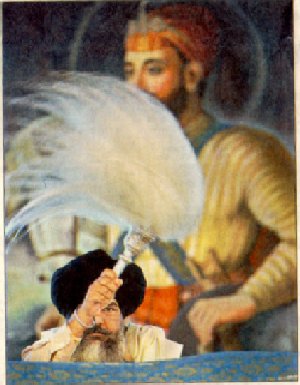
Bee photograph Chris Crewell
Darshan Singh signals the end of religious ceremonies dedicating the Guru Ram Das Khalsa preschool. The new school is the first Sikh school in Northern California.
Sacramento Bee, March 9, 1998, Section B, 1 (with permission)
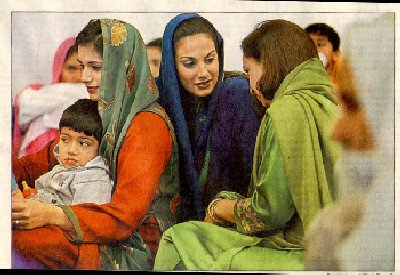
Bee photograph/Chris Crewell
Harpeet Bains of Yuba City, left, holds son Barron, 3, while Diljit Bains, center, and Nina Gill talk Sunday after a 72-hour prayer to bring good luck to the new Guru Ram Das Khalsa preschool in Yuba City.
Sacramento Bee, March 9, 1998, Section B, 1 (with permission) by Peter Hecht, Bee Staff Writer.
Sikhs Come Together to Celebrate Opening of Yuba City School
Yuba City - For members of the Sikh religious community in Sutter County and across the Sacramento region, the Guru Ram Das Khalsa preschool was a long held dream.
For years, many in the 10,000-member Sikh community had talked about opening a school to provide a multicultural education for their children, who were quickly assimilating into American society without learning the language, culture and history of their ancestors.
On Sunday, scores of Sikhs gathered to celebrate the opening of the first Sikh school in Northern California.
The Guru Ram Das Khalsa school, opened in converted offices at the Sikh Temples in Yuba City, will start as a preschool for children for ages 3 to 5. It will eventually expand to serve children in kindergarten through the third grade.
The church is building a permanent school on Lincoln Road in Yuba City.
"More than anything, we saw that with each generation, our youth was losing touch with their culture," said Diljit Bains, a real estate developer in the Yuba-Sutter region and a member of the board of trustees for the new school. "I think that culture needs to be put back into the schools to maintain it. "
On Sunday, as some the first 30 preschoolers excitedly cavorted on the playground, the proud adults dined on potato samosas, a carrot dessert and eggless cake.
For 72 straight hours prior to the celebration, members of the Sikh community had honored the school by praying in alternating shifts-reading from the Guru Granth Sahib, the 1,430-page collection of writing from Sikh holy masters.
Dr. Jasbir Kang, a Yuba City physician and another member of the school's board of trustees, said he is pleased that many of the children will be able to learn the native language-Punjabi-of their India-born parents. But he also said the school will have both Sikh and non-Sikh teachers to give pupils a multicultural experience.
"To be successful in America, you have to have a secular perspective-and at the same time be aware of your own religion and culture," Kang said. "We are not trying to isolate ourselves. We are adding to the beauty of ourselves. We are adding to the beauty of America. These kids are going to pick up the good from both cultures."
Source: Sacramento Bee Monday 3/9/1998 B1, B3, Col.1 (with permission)
|
|
One Hundred Years of Immigration to Canada
Released April 19, 1999 by Canada Post, the new 46
cent stamp features a double-edged sword, a circle and two daggers
in bright gold against a blue background representing the Khanda,
which is to Sikhs what the cross represents to Christians and the
Star of David to Jews.
Khanda is a metaphor of divine knowledge, its sharp edges
cleaving truth from falsehood. Encircling the sword is the Chakra.
Symbolizing God, it is a ring - a shape without beginning or end.
Designed by Stacy Zabolotney, the stamp is to commemorate 100
years of Sikhs in Canada. It was officially launched by Prime Minister
Jean Chretien of Canada, Post chairman Andre Ouellet and Revenue
Minister Harbans Singh Dhaliwal.
Mr. Dhaliwal said that "for 100 years, Sikhs have been an integral
thread in Canada's mosaic. Their dream, my dream, has been to get
the recognition they deserve for the the contribution they have
made to building Canada. Well, it happened. Only in Canada, eh?"
|
 Go to top of the page
Go to top of the page
DOSANJH IS BRITISH COLUMBIA PREMIER
Feb. 21,2000 - It was a big day for Punjabis. One of them, Mr. Ujjal Dosanjh today became the Premier of British Columbia, a prosperous and important state [i.e. Province] of Canada.
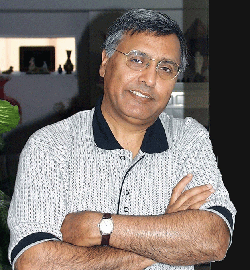
There was thunderous applause when the results were announced. Mr. Dosanjh was present along with his wife Raminder Kaur Dosanjh, and three sons, Pavel, Assem and Ambar, to receive the standing ovation. Mr. Dosanjh told the delegates that the election of a once immigrant worker to such a high place showed the committment of the Canadian people.
He talked about his Punjabi background, the role of Ghaddarite freedom fighters and other political forces committed to social justice and human welfare. He promised to uphold these traditions.
Mr. Dosanjh will be sworn in as Prime Minister [i.e. Premier] by the Governor [i.e. Lieutenant Governor], Mr. G Gadown, in Victoria on Wednesday. Five days later he will announce his Cabinet.
| From
Komagata Maru to Premier |
Born in Dosanj Kalan village of Jalandhar district, Mr.Dosanjh belongs to a family of freedom fighters. Mr. Dosanjh, the first Indian to become a Premier of any Canadian state [i.e. Province], said: "My victory is a tribute to the freedom fighters of the Kamagata Maru. They set the pattern for us to fight for freedom and democracy. We salute all freedom fighters and those who cherish social and human values."
Asked how he felt as once he was an immigrant worker and how should people in India and Punjab in particular, think about his victory, Mr. Dosanjh said: "I remember my maternal grand father in Bahwa village of Hoshiarpur. He would take us on a wooden cart and tell us stories about Kamagatu Maru, the gurdwara reform movement and about Mahatma Gandhi and Nehru of the freedom movement. Something went deep and influenced my thinking. When I came to Canada after spending sometime in England, I worked hard to earn a living and then became a lawyer, I was always busy in the trade union movement and later the New Democratic Party. Our committment is to social democracy. I salute the country of my origin and my Punjab and the people."
"I migrated at the age of 17, but have never forgotten my roots. I have visited Punjab repeatedly and have tried to set up joint ventures with the help of my colleagues. I look forward to doing something tangible for Punjab. We can help in setting up joint ventures in several areas," he added.
Mr. Dosanjh said it was true that the first committment was to Canada and British Columbia, but India was there in his heart. "We strongly believe in the unity and prosperity of India, a modern secular democratic India committed to the welfare of its people. We want to see the land of our origin prosperous and any help would be an honour," he said.
Mr. Dosanjh is the 34th Prime Minister [i.e. Premier] of British Columbia, the state [Province] born in 1871. His wife Mrs. Raminder Kaur Dosanjh is working and his three sons are studying in universities. The entire family was there to recieve the applause after his election as leader of the New Democratic party.
SOURCE:Tribune India. Online editors. Feb. 22, 2000.
Immigration from India to the
U.S. from 1820 to 2000
|
Period
|
Number of Immigrants
|
|
1820
|
1
|
|
1821 - 1830
|
8
|
|
1831 - 1840
|
39
|
|
1841 - 1850
|
36
|
|
1851 - 1860
|
43
|
|
1861 - 1870
|
69
|
|
1871 - 1880
|
163
|
|
1881 - 1890
|
269
|
|
1891 - 1900
|
68
|
|
1901 - 1910
|
4,713
|
|
1911 - 1920
|
2,082
|
|
1921 - 1930
|
1,886
|
|
1931 - 1940
|
469
|
|
1941 - 1950
|
1,761
|
|
1951 - 1960
|
1,973
|
|
1961 - 1970
|
27,189
|
|
1971 - 1980
|
164,134
|
|
1981 - 1990
|
250,786
|
|
1991 - 2000
|
363,060
|
India-born Population in U.S. Exceeds
One Million
India-West, February 15, 2002. pg. A1
Sources:
1. U.S. Immigration and Naturalization Service. Annual Report, 2000 (Washington
D.C., 2000). Pp. 7-9
2. India-West. Vol. 27 n.15. February 15, 2002. Los Angeles, CA. pp. A1,A42
Steps for how to access: 'Census 2000 Data for the State of California' for Asian-Indian population
1. Go to the following web address: http://www.census.gov/Press-Release/www/2001/tables/redist_ca.html *SEE BELOW
2. Underneath the 'Demographic Profile' table, click on the PDF version of the 'Profiles of General Demographic Characteristics: California'
3. To the left of the computer screen, you will see a list of cities and counties. Click on the city or county of your choice.
4. Under the first Subject column, scroll down to the second subject which is Race.
5. Under the title Asian, you will see the subtitle Asian Indian. Next to that you will see the population number.
*For step number one, if you would like the census information for a
different state, other than California, go to the last part of the address
'ca.html,' and change 'ca' to the two-letter initial of the state of your
choice.
| Prime Minister gave Abbotsford Sikh
Temple heritage status Official heritage designation for the old Abbotsford Sikh Temple on South Fraser Way was conferred on July 31, 2002.. Prime Minister Jean Chretien, Heritage Minister Sheila Copps and B.C. MP were on hand at the old temple on South Fraser Way for the long-awaited heritage announcement. Built in 1911 by Indo-Canadians who worked at Abbotsford Lumber Company, the wood-frame structure was the second such structure built on the continent, city councillors were told when asked to support heritage designation. Ceremonies began at 1p.m. "We're very excited about it," Sangha said when the announcement was made last week. "We expect about a thousand people." The temple will be restored to its original condition, with a museum of Sikh history in the lower floor. The upper floor will be retained as a place of worship. The Canadian Prime Minister J-C designated Guru Nanak Gurdwara as a historic on Wednesday July 31st. This or the function was attended by Heritage Minister Sheila Copps and B.C. Liberal MP Herb Dhaliwal and about 3 Sikhs of British Columbia. |
|
First Indian in the US Army killed in Iraq
Lt. General James Campbell attened funeral in Chandigarh
US Salutes Son of India: http://www.tribuneindia.com/2003/20031212/chd.htm
Sikhs remember first Indian to die in Iraq: http://www.sikhmediawatch.org/news/newsdetail.asp?newisd=581
U.S. Army Specialist Uday SIngh, a Sikh AMerican SOldier from Lake Forst Illinois, Died During Combat in Iraq: http://www.punjabiamericanheritagesociety.com/news/2003/2003-12-01.htm
2004 "Sikhs: Legacy of the Punjab"
The new exhibition "Sikhs: Legacy of the Punjab" opens on July 24, 2004, at the National Museum of Natural History, Smithsonian Institution. The exhibition introduces visitors to the cultural and artistic history of the Sikhs. It presents Sikh artwork and artifacts produced from the eighteenth century to the present, including miniature paintings, armor and weaponry, traditional textiles and dress, coins, musical instruments, jewelry, sacred texts, and modern works of art. It also includes a scale model of the Darbar Sahib (so-called "Golden Temple"), a Sikh sacred space at Amritsar, India. Many of these objects are on loan from private collections and will be exhibited for the first time. This exhibition is organized by the Museum's Sikh Heritage Project, a research and outreach component of the Asian Cultural History Program, Department of Anthropology.
Exhibit Photos | Exhibit Slideshow
"Sikhs: Legacy of the Punjab" at the National Museum of Natural History, Smithsonian Institution, July 24, 2004
2004 "White House marks 400th anniversary of Guru Granth Sahib"
Washington, August 20
Spiritually uplifting cries of ғBole So Nihal-Sat Sri Akal'' rented the White House as it marked 400th anniversary of the Guru Granth Sahib, the first Sikh event it celebrated in 100 years.Department of Health and Human Services Secretary Tommy Thompson welcomed the Sikhs by saying 'Bole So Nihal'' as the guests responded to the greeting with a loud 'Sat Sri Akal.
You have strengthened the USA and we can count on you to play an important role in making this country strong. Your religion was founded to bring justice, to defend the weak and oppose tyranny, Mr Thompson added.
'I congratulate you on the 400th anniversary of the Guru Granth Sahib on behalf of President Bush who has high regards for your community,'' A Sikh Council on Religion and Education (SCORE) statement quoted President George W. Bush's cabinet member Thompson as telling the community members on Wednesday.
Before attending a meeting with administration officials, Sikh religious and community leaders watch as President George W. Bush departs from the White House aboard Marine One on Wednesday.
Ten Sikhs were also invited by the White House in the morning to be present while President Bush was to leave for Minnesota for an election meeting.
President Bush waved at the Sikhs and greeted them with a thumbs up, a council member said.
A picture of the Sikhs waiving while President Bush's helicopter was leaving has been posted at the official website of the White House.
A commemorative coin depicting the White House on one side and the handwriting of Guru Arjan Dev, the compiler of the Sikh scripture, on the other was released and presented to Mr Thompson by Prof Darshan Singh.
A special booklet was also released describing the history and the message of the Sikh scripture and which traced the 100-year-old history of the Sikhs in the USA. UNI
Source: Tribune India 8/31/04.
Sikhs visiting the White House.
(Picture courtesy of Dr. J. S. Kang)
2004 Second Indian-American Elected to Congress
INDIAN AMERICAN CANDIDATE
ELECTION SUMMARYNovember 2, 2004
Bobby Jindal(R-Louisiana)
U.S. House of Representatives, Louisiana 1st Congressional District WON
with 78.3% (217,719) of the voteSwati Dandekar (D-Iowa)
Iowa House of Representatives, District 36
WON with 54.4% (9,772) of the voteNikki Randhawa-Haley (R-South Carolina)
South Carolina House of Representatives, District 87
WON with 98.9% (14,420) of the voteShinku Sharma(Calif.)
Board Member, Saratoga Union School District (Santa Clara County) WON
with 25.5% (1,895) of the voteJagrup Sidhu(Calif.)
Council Member, Kerman City Council (Fresno County)
WON with 41.4% (937) of the voteHarry Sidhu (Calif.)
Council Member, Anaheim City Council (Orange County)
WON with 18.3% (17,846) of the voteMital Gandhi(DC)
Advisory Neighborhood Commission of Northwest Washington
WON with 59.3% (303) of the voteRajendra Ratnesar(Calif.)
Member, Board of Directors, Eden Township Health Care District (Alameda County)
WON with 35.8% (35,794) of the vote
___________________________________Sylvester Fernandez (R-New Jersey)
U.S. House of Representatives, New Jersey 6th Congressional District
Lost with 31.0% (69,389) of the voteJay Rao(R-North Carolina)
North Carolina Secretary of State
Lost with 42.9% (1,327,265) of the voteBrian Jayakumar(D-New York)
New York State Senate, District 47
Lost with 31.5% (29,762) of the voteSid Das (D-New Hampshire)
New Hampshire House of Representatives, District 27 (Hillsboro County)
Lost with 2.6% (5,204) of the voteRano Singh(D-Arizona)
Arizona House of Representatives, District 6
Lost with 26.3% (19,195) of the vote (98.3% of Precincts Reporting)Eduardo Bhatia (PPD-Puerto Rico)
Mayor of San Juan
Lost with 46.3% (89,916) of the voteLakhvir S. Ghag(Calif.)
Council Member, Live Oak City Council (Sutter County)
Lost with 23.5% (478) of the voteKash Gill (Calif.)
Council Member, City Council of Yuba City (Sutter County)
Lost with 17.4% (4,421) of the voteGeorge James(R- New Jersey)
Council Member, Borough of Westwood Council
Lost with 24.3% (2,245) of the vote (96% of Vote Reporting)Gyan Kalwani(Calif.)
Council Member, Elk Grove City Council, District 5 (Sacramento County)
Lost with 12.9% (3,494) of the voteSheela Kini (Calif.)
Supervisor, County of San Francisco, District 7
Lost with 1.1% (249) of the voteDeepka Lalwani(Calif.)
Council Member, Milpitas City Council (Santa Clara County)
Lost with 18.7% (3,429) of the voteTej Maan (Calif.)
Council Member, City Council of Yuba City (Sutter County)
Lost with 6.8% (1,730) of the voteNarinder K. Mann(Calif.)
Council Member, Kerman City Council (Fresno County)
Lost with 22.4% (507) of the voteAtul Mitra (Calif.)
Board Member, New Haven Unified School District (Alameda County) Lost
with 16.7% (5,452) of the voteJay R. Shah (Calif.)
Supervisor, County of San Francisco, District 2
Lost with 4.0% (1,020) of the voteShantu Shah (Oregon)
Board of Director (Position 1), of the Proposed Washington County Public
Utility District Lost with 13.2% (33,720) of the voteRakesh Sharma (Calif.)
Council Member, Fremont City Council (Alameda County)
Lost with 13.5% (11,263) of the votePaul Reuben Singh(Calif.)
Council Member, Live Oak City Council (Sutter County)
Lost with 16.2% (330) of the vote* Election results are courtesy of the Indian American Leadership Initiative (IALI) and the Indian American Center for Political Awareness (IACPA)
(Source: Bicky Singh. November 2004.)
 Go to top of the page
Go to top of the page
Contact T.S. Sibia, tssibia@sikhpioneers.net